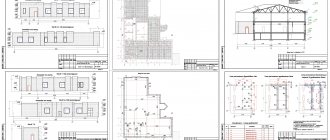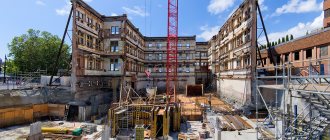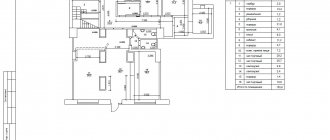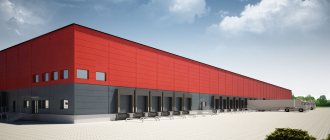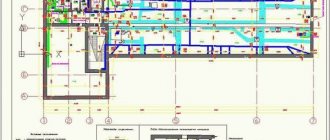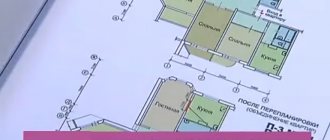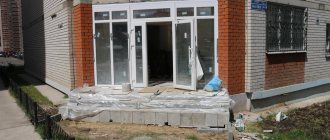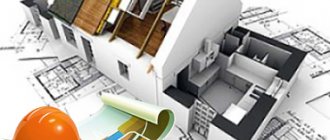What is the construction of a new property is clear to many, but reconstruction work is often confused with changes that relate to major repairs of a property or redevelopment with reconstructive changes . So what is the reconstruction of a capital construction facility - OKS?
Reconstruction is a complex of coordination and general construction work aimed at changing the technical and economic parameters (TEPs) of a real estate property, in which it is necessary to develop and obtain a large volume of design and technical documentation. Such changes include:
- increasing the area of the property by adding premises and floors;
- expansion of the facility by adding a usable area “to the side”;
- replacement or restoration of load-bearing structures not partially (this is possible redevelopment), but as a whole.
In simple terms, reconstruction is an increase in the construction volume and total area of the OKS. Reconstruction is also considered a change in the engineering equipment of a facility. These works are directed according to the definition of paragraph 14 of Art. 1 of the Town Planning Code for the improvement and improvement of OKS in terms of physical wear and tear. Such changes subsequently lead to changes in the height of the building, the number of storeys of the facility, and an increase in the total area.
The procedure for obtaining permission for reconstruction is different for non-residential buildings and for residential ones. For individual residential development on lands for individual housing construction or private plots, the procedure is much simpler and has a notification nature of approval.
The basis for reconstruction may be the owner’s decision to increase the usable area of the premises, building, or structure.
Also, the basis is the poor or critical condition of the load-bearing structures, confirmed by defective statements or justification of the examination or technical conclusion on the emergency condition of the load-bearing structures, the operation of which creates a risk or threat to people.
Does it take long to read the description?
Call +7 , we will immediately answer all questions. Write a request to [email protected] with a clearly described essence of the question or task, we will answer.
Reconstruction in construction is
So, as a general rule, any change in the characteristics of a real estate property associated with a change in its built-up area (external configuration), number of floors or a change in its load-bearing structures will be considered reconstruction. The exact definition of the concept of reconstruction of a real estate property is contained in Article 1 of the Civil Code of the Russian Federation.
As a rule, the reconstruction of objects is subject to the receipt of a special document called a construction permit. During reconstruction, the quality characteristics of the property change, while its purpose remains the same. There is an opinion, confirmed, among other things, by the position of the Ministry of Economic Development and Rosreestr, that as a result of reconstruction, two real estate objects can be formed from one.
You should know! The concept of reconstruction assumes that the property being reconstructed already exists and it certainly must not be unfinished. Construction, on the contrary, begins with surveys, preparation of the zero cycle, foundation. This is the difference between reconstruction and construction.
Responsibility for unauthorized alteration
Some owners do not want to deal with the troublesome task of collecting documents for reconstruction and carry out the work at their own peril and risk. But it should be understood that such actions are punishable, everything is clearly stated in the Code of Administrative Offenses of the Russian Federation:
- For reconstruction without permission, a fine will be imposed from two to five thousand rubles (for individuals) or from twenty to fifty (for officials, for individual entrepreneurs). A very serious fine is provided for a legal entity - from half a million to one million rubles, or the company’s activities will be suspended for 90 days. (Clause 1 of Article 9.5 of the Code of Administrative Offenses of the Russian Federation).
- For illegal commissioning of a capital construction project after reconstruction, a fine of up to one thousand rubles (for individuals) or up to two thousand rubles (for officials) is provided; a fine of up to 20 thousand rubles may be imposed on a legal entity. (Clause 5, Article 9.5 of the Code of Administrative Offenses of the Russian Federation).
Features of obtaining permission for reconstruction in the Subjects
It should be especially noted that the Civil Code of the Russian Federation establishes the possibility of expanding this list when permission for the reconstruction of an industrial building at the level of the constituent entities of the Russian Federation is not required. As a rule, each subject has adopted its own regional law or by-law, which contains an additional list of types of construction work for which a permit for the reconstruction of a building is not required
So, in particular, in the Leningrad Region, peasant farms are not required to obtain permission to reconstruct facilities located on agricultural lands, subject to certain conditions:
- the lands must be part of the peasant farm;
-the number of floors should be no more than 2;
-the purpose of using the constructed facilities must be inextricably linked with the activities of the peasant farm.
These rules are established by the regional law of the Leningrad region.
When is permission needed?
First, you need to decide whether your situation requires a permit. It will have to be obtained if the following changes are planned:
- increasing or decreasing the number of storeys;
- reconstruction of the attic into an attic room;
- organizing the extension of the mezzanine floor;
- extension of additional non-residential premises;
- strengthening the structure and changing the location of communications in case of major repairs.
Works on this list require mandatory approval. If this requirement is ignored, the work will be considered illegal.
Illegal reconstruction what to do
Very often situations arise when documentation for reconstruction was not received in the prescribed manner; in this case, the reconstructed object will have the status of unauthorized construction. Taking into account such circumstances, authorities or local self-government make a requirement to bring the unauthorized building to its original condition. Such a requirement can be made both in court and out of court, if the object is located on state or municipal land.
What to do in this case, for this let's look at some input data that is available in the case of unauthorized construction.
Increase in area
If during the reconstruction process it is planned to increase the area, it is necessary to additionally obtain permission from the BTI. To do this, you need to invite a technician who will take the necessary measurements and conduct an examination on the possibility of reconstruction. It is important to prevent the transfer of load-bearing walls and ceilings without permission. This creates a dangerous situation for everyone in the building. This is especially important when it comes to a residential building.
If you have planned additional extensions, their need will have to be justified. This could be a veranda or a separate room for household needs. If we are talking about an apartment building and an entrepreneur wants to complete the construction of a commercial premises, this will be reflected in the inventory value of the entire building. The Tax Service regards such actions as a violation of tax discipline, which is not considered acceptable.
When permission is received to increase the area through extensions, a commission is invited upon completion of the work. If the reconstruction carried out corresponds to the declared project, an act signed by the responsible persons is issued. It must be submitted for registration to the nearest department of Rosreestr.
The reconstructed facility is located on municipal or state land
In this case, in addition to having to prove the legality of the reconstruction of the object, it will also be necessary to justify that the property was originally erected in a legal manner on the land plot on which it is located with the receipt of all necessary documents (if they were required for this period).
In addition, in this case it will be necessary to challenge the decision of the local government to demolish or restore the object to its original condition, since the demolition of the object occurs out of court.
Let us give an example of a situation regarding this problem. In the 60s, land acquisition was carried out for the construction of boat garages. On this plot of land, boat garages were built, which are still in use today, but the land under the garages has never been surveyed, and there is no permission to build garages. In 2010, these garages were reconstructed. The district administration issues a resolution on the demolition of these objects, citing the fact that they were erected illegally and after that their illegal reconstruction was carried out. However, garage users will successfully appeal this demolition order in court and declare it illegal. The legality of the construction of these objects was confirmed by land allocation documents, as well as by the legislation of the 60s of the last century, according to which permission to build a garage was not required. The possibility of reconstructing these objects without a building permit is provided for in Article 51 of the Civil Code of the Russian Federation, namely, permission is not required for the reconstruction of garages.
Approval procedure
Any actions with residential or non-residential assets require approval. This process is not very complicated, but it requires time, since you need to visit many authorities. The first step is to obtain a copy of the building's technical certificate. This is not difficult, since such a document is issued at the request of the property owner in the BTI. Together with the above documents, it is submitted to the city department of architecture. It is also necessary to order a reconstruction project. You will also need to contact the sanitary and epidemiological station, utility services, and fire inspection. Regarding public utilities, a visa from them is required if there is interference in engineering systems: heating, water supply, electrical wiring, gas supply. The next authority you will have to contact is the housing commission. She is the one who draws up the certificate of work completed. After this, the documents are transferred to the municipality.
The reconstructed facility is located on private land
In this case, the requirement to bring the reconstructed object to its original condition can be made by a state or municipal authority only in court.
The fact of reconstruction of the object without permission will be subject to proof. The line of defense in this case may be that a building permit was applied for, but the authorities illegally refused to allow reconstruction. Or the reconstruction was carried out in relation to an object for the construction of which such a permit is not required.
As an example, we can cite a situation where an organization carried out construction work on a residential building, but did not receive approval for the reconstruction of the house. Then, for inclusion in the Unified State Register of Real Estate, a technical plan was prepared to change the area and contour of the building. The technical plan was accompanied by a conclusion from an expert construction organization, which stated that the load-bearing structures of the building were not affected during the reconstruction. However, Rosreestr refused to take into account the changes; the refusal was successfully appealed in court with a forensic examination, which also established that the design characteristics and reliability of the object were not affected.
As we see, in order to legitimize the reconstruction, special construction conclusions can be used, however, this method only works if the reconstruction of the building does not really affect any load-bearing structures
Conducting engineering surveys
When preparing a reconstruction project, according to Article 47 of the Town Planning Code of the Russian Federation, engineering surveys are required. They are carried out by organizations or individual entrepreneurs that are members of a self-regulatory organization in the field of engineering surveys (SRO). These surveys are carried out by studying the site and object, as well as technical and title documentation.
Engineering surveys when preparing a reconstruction project are carried out to obtain data:
- about the possible impact of technogenic factors on the environment;
- on the validity of decisions on architectural, space-planning work, engineering protection design, and facility layout;
- on calculations of foundations, foundations and structures;
- on the possibility and feasibility of carrying out excavation work.
This is interesting!
“Features of object reconstruction depending on its type”
More details
Complete engineering surveys are documented in a single document. This document is used to develop the project and its subsequent approval.
Reconstruction permit for building extension
The provisions specified in this article are fully valid during the reconstruction of premises located in the building. If, when carrying out work in a building, the common staircase openings and other objects that are in the common ownership of the owners of the premises are affected, then in this case, before reconstruction, it is necessary to obtain the consent of all owners of the premises in the building. It should be noted that even if the owner of the premises receives permission for reconstruction from the authorities, the lack of consent of the other owners of the common property in the building can lead to negative consequences. Thus, upon the claim of the remaining owners of the common property in the building (owners of other premises), the issued building permit for reconstruction may be declared invalid.
Therefore, when determining whether a permit is needed for the reconstruction of a non-residential building, it is also necessary to establish the attitude of other owners of non-residential premises towards the construction work.


